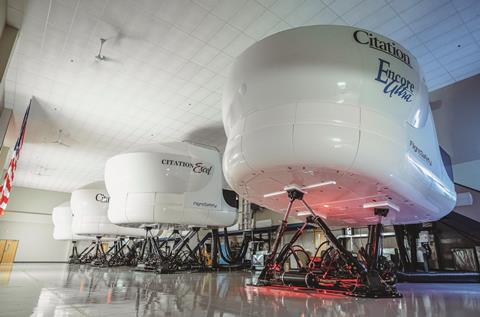Why practise in a simulator when an aircraft provides a more realistic experience? Well, for a start, it does not. A training device can teach a pilot to prepare for a host of scenarios and ultimately become a safer aviator
It is easy to come up with reasons not to pay for your flight crew to train on a simulator beyond the minimum required to be legal. After all, aside from the cost and time away from the job, what could be more useful for any pilot than building sharp-end experience in the cockpit of an actual aircraft?
However, rejecting simulation training from a professional organisation is, at best, a false economy and, at worst, risking your employees being unprepared for what could confront them in the skies, asserts Brian Moore, senior vice-president operations at FlightSafety International.

“You can do things in a simulator that you just can’t do safely training in an airplane,” he says. “You can simulate an electrical malfunction, fail busses or circuit breakers. You can actually go through all these scenarios and see how the pilot reacts, making them much more prepared.” The paradox of modern simulators is that, due to advances in visuals and kinetic technology, they can realistically create the sort of unexpected conditions in which a pilot might find themselves, with one big difference – unlike an aircraft, the device is bolted to the floor and cannot crash.
This means that pilots who have received extensive simulator training are usually much better equipped for any- thing that the job throws at them. “You are going through all these situations and learning how to deal with them,” says Moore. “You are prepared.”
He cites the example of inclement weather. “A training flight in an aircraft would probably not take off in the worst conditions. But that is when pilots get really stressed in the real world, even when something relatively minor goes wrong,” he says.
“In a simulator, we can put the pilot in bad weather, at night and with ATC [air traffic control] barking at them. Then we can throw in a small malfunction to see how they cope with that with everything else going on.”
The idea is not to stretch the pilot’s nerves to breaking point, but to assess their response under pressure. “A lot of the learning comes in the debrief. Did they rise to the challenge or get stressed?” says Moore. “Questioning what went well and what could have gone better leads them to self-discovery.”
Another objection often made to simulator training is cost, but “this often catches folk by surprise”, suggests Moore. “When you look at all the indirect costs of training in an aircraft, when you really put pen to paper, you realise the cost might be close to equal or even more,” he says.
Using a business or private aircraft for training pilots is also not putting an expensive asset to its best use, argues Moore. “Most people didn’t buy their aircraft to train pilots in. It was bought as a business tool, to move people or cargo from place to place.”

However, there is a more fundamental issue when it comes to the price of simulator time. “People might think training is costly, but so are mishaps,” he says. “If training keeps you out of trouble that certainly saves a lot of cost to the business.”
Moore accepts that convincing aircraft owners of the value of simulator training can be harder in certain parts of the world. “In North America, the concept has been around a long time, and there is broad acceptance. Europe is the same,” he says.
“However, when you start branching out to newer markets there is sometimes less familiarity and under- standing of the value proposition, and our teams have to work harder and have these conversations when cost is a big driver and there are issues of having pilots away for long periods.”
In these instances, it is not just FlightSafety representatives doing the persuading, however. “Word of mouth becomes vital,” he says. “A lot of people we have trained really see the value of it. Customers become our best ambassadors.”
Ultimately, FlightSafety’s mission is to change the mind- set. “Training is not just about making a pilot proficient,” says Moore. “We want better than that. We want pilots to be prepared, who can rise to whatever occasion presents itself and get the aircraft onto the ground safely.”
Training, he concludes, should not just be “regulatory- based with some safety aspects sprinkled in”. Instead, the emphasis should always be on “safety-based training that happens to meet the regulations”.
























